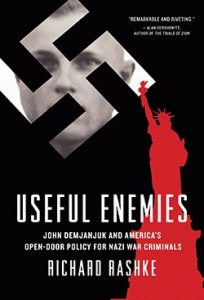Alex Constantine - May 24, 2013
" ... In 1950, Congress passed the Lodge Act, which gave the U.S. military the authority to recruit immigrants into the U.S. Army to help fight the Cold War. It wasn’t just the military, but the FBI, the State Department, and the CIA which helped itself to not only Nazis, but Eastern European Nazi collaborators such as members of Croatia’s Ustasha, Hungary’s Arrow Cross, and the Romanian Iron Guard. ... "
Why did the United States feel the need to admit Baltic and Eastern Europeans who at times exceeded the Nazis in brutality?
BY
 Lost count of the sordid episodes in America’s past? In Useful Enemies: John Demjanjuk and America’s Open-Door Policy for Nazi War Criminals (Delphinium Books, 2013), Richard Rashke chronicles one that few of us know much about. Many Americans have heard of Operation Paperclip, the program run by the Office of Strategic Services (the predecessor to the CIA). After World War II, the United States made the cold calculation to recruit Nazi scientists both to secure their help in the Cold War and to keep Russia from acquiring their expertise.
Lost count of the sordid episodes in America’s past? In Useful Enemies: John Demjanjuk and America’s Open-Door Policy for Nazi War Criminals (Delphinium Books, 2013), Richard Rashke chronicles one that few of us know much about. Many Americans have heard of Operation Paperclip, the program run by the Office of Strategic Services (the predecessor to the CIA). After World War II, the United States made the cold calculation to recruit Nazi scientists both to secure their help in the Cold War and to keep Russia from acquiring their expertise.
Rashke explains that, even though the United States enacted the Displaced Persons Act and a special Displaced Persons Commission (DPC) to determine which European organizations’ members were to be denied U.S. visas
… it is safe to say that the United States used, protected, and opened the door to several thousand former SS and SD officers, Gestapo agents and chiefs, Abwehr intelligence officers, Nazi propagandists and scientists, Einsatzkommandos, Waffen SS volunteers, Vlasov’s army soldiers, Nazi quislings, and ethnic cleansers.
Vlasov’s army was the Russian Liberation Army composed of Russian prisoners of war opposed to communism. Einsatzkommandos were members of Nazi mobile killing squads known as Einsatzgruppen. The Waffen, Raschke writes, was
… defined as criminal by the Nuremberg International Military Tribunal and … by the DPC. [Its] battalions were made up of mostly non-fighting German volunteers. Besides fighting the Soviet army, Waffen SS volunteers executed Soviet POWs and assisted the Nazi Einsatzgruppen in rounding up, robbing, and killing Jews, Gypsies, and communists.
But
In September 1950, the DPC made a controversial decision that opened America’s door for a group of Latvian and Estonian Waffen SS who had survived the war. … A brief review of the scope and brutality of Estonian and Latvian collaboration with the Nazis helps explain the angry reaction of the Jewish community to the … decision and the impact the ruling had on U.S. immigration policy. [The Latvian and Estonian Waffen SS] were brutal. They raped and forced women to work as sex slaves, then killed then when they were worn-out; they tossed babies in the air for target practice; and they buried wounded victims alive.
Then, Rashke explains, in 1950, Congress passed the Lodge Act, which gave the U.S. military the authority to recruit immigrants into the U.S. Army to help fight the Cold War. It wasn’t just the military, but the FBI, the State Department, and the CIA which helped itself to not only Nazis, but Eastern European Nazi collaborators such as members of Croatia’s Ustasha, Hungary’s Arrow Cross, and the Romanian Iron Guard.
These included Andrija Artukov, known as the “Himmler of Croatia,” and Viorel Trifa, an Iron Guard leader responsible for the murder of thousands of Romanian Jews. Once in the United States, Trifa was made a bishop by the the Ukranian Orthodox church. A loyal anti-communist, he became a watchdog for J. Edgar Hoover in the Romanian community. Meanwhile, although Nicolae Malaxa, another Iron Guard leader, was a communist agent, he was allowed to emigrate and stay because he was also operating undercover for the National Intelligence Agency. Rashke writes
How America welcomed … major war criminals stands in stark contrast to how it hounded minor war criminal John Demjanjuk.
If you haven’t followed Demjanjuk’s case, like I hadn’t, Useful Enemies is suspenseful. What led to Demjanjuk being singled out? In 1973 Rep. Elizabeth Holtzman (D-NY), a member of the House Subcommittee on Immigration, got a call from an Immigration and Naturalization Service (INS) bureaucrat who told her that the INS was in possession of a list of Nazi war criminals living in America who it was making no attempt to deport.
When the files were released to Rep. Holtzman, she found Artukovic and Trifa especially troublesome. The FBI moved to protect the two, but when Rep. Holtzman secured Russia’s cooperation in rooting out Nazi collaborators, Secretary of State Kissinger authorized an overture to Moscow and the INS released its list to the public. One of the names on the list was Iwan (John) Demjanjuk. He was a Russian solder captured by the Germans and enlisted into the Trawniki corps of Russian POWs, who were used to round up and kill Jews in concentration camps.
It appears that, once the United States was finally ready to make amends for its inaction on Nazis and Nazi collaborators, it fingered someone low on the food chain. But to give the devil its due, it thought he was more of a predator – a guard and gas chamber operator at Treblinka known as Ivan the Terrible whose sadism was off the charts – than he turned out to be.
Useful Enemies then becomes a gripping courtroom drama. Much of the case revolved around the authenticity of a Trawniki identification card apparently issued to Demjanjuk by Nazi bureaucracy. Over the course of 30 years of trials and a deportation hearing, a climax – no, anticlimax – was reached in1993 when he was found innocent by an Israeli court because the prosecution couldn’t establish that he was Ivan the Terrible. But, deported to Germany, in 2011, Demjanjuk was finally convicted instead for his role as a guard at Sobibor in 2011. (He died in 2012.)
Reading Useful Enemies, your emotions are apt to veer wildly from, in the early going, hoping Demjanjuk is found guilty to, when it becomes increasingly apparent that he’s not Ivan the Terrible, damping down your sympathy for this man. On the one hand, he’s being persecuted, but, on the other, he was obviously complicit in the Nazi war effort.
In the end, as Rashke makes clear:
If Nazis form the first tier of war criminals and Nazi collaborators the second tier, then the FBI, the State Department, the military, and the CIA have created a third tier – those policy makers, leaders, and implementers who hired, used, and protected thousands of men and women who had committed crimes against humanity.
What did the United States get out of this? Some scientific accomplishments from the Nazis granted admittance such as Wernher von Braun, whose work helped land a man on the moon and who was ultimately awarded the National Medal of Science. On the other hand, from the Eastern Europeans, shoddy or false intelligence (not that Nazis deserved to be admitted any more than them!). Just when its moral authority, whether deserved or not, was at an all-time high after World War II, the United States couldn’t get off its war footing and insisted on treating the Soviet Union as a threat on a par with Japan and Germany.
In the end all American immigration policies toward Nazis and their collaborators thought to be useful to the United States did was throw fire on the fuel of the Cold War. It also eroded the moral standing of the United States, as well as dishonored the memories of all those who lost their lives to Nazis and their Eastern European and Baltic collaborators.
From a historical perspective, World War II is a gift (if you can call it that) that never stops giving. Seventy years on, new truths continue to be unearthed. As if our minds hadn’t recoiled enough from the atrocities of World War II, the author turns over a new stone out from which human vermin like the Ustasha, Arrow Cross, and Romanian Iron Guard slither.
Richard Rashke’s voluminous research on U.S. immigration policies will be new to many. But, since it will likely establish itself as the definitive book on the subject, Useful Enemies is the best place to start.
Cross-posted from the Foreign Policy in Focus blog Focal Points.







